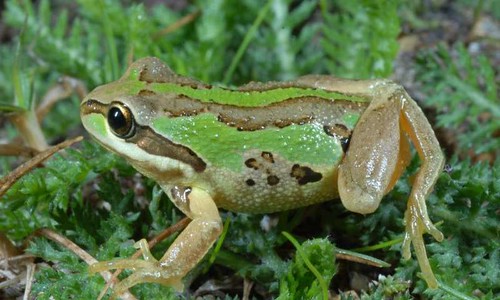除了南極洲,世界五大洲的青蛙都面臨致命壺菌蔓延的危機,但科學家最新研究發現,有些澳洲原生蛙種卻能抵抗壺菌,得以存活。
研究作者、澳洲國家大學博士Ben Scheele表示,「我們能為這些物種付出的微薄心力,就是避免棲地流失。」
 |
| 可以戰勝壺菌的高山樹蛙(alpine tree frog)。David Hunter提供。 |
青蛙界的SARS 非洲爪蟾帶著壺菌遊世界
壺菌的帶原者是對壺菌免疫的非洲爪蟾。1934年人們發現非洲爪蟾可以用來驗孕後,數十年來不斷出口到全世界。「青蛙透過接觸水和其他青蛙感染壺菌。壺菌會攻擊皮膚,讓被感染的蛙呼吸困難,導致心跳停止。」
「此後截至目前已經有超過500種兩棲類感染壺菌,分布南極以外的各大洲,」這導致超過200種物種的數量減少,其中113種可能已經滅絕。
根據澳洲研究會(ARC)環保決策卓越研究中心(Centre of Excellence for Environmental Decisions)的研究,鳴樹蛙(whistling tree frog)和高山樹蛙(alpine tree frog)都能戰勝壺菌,但極度瀕危的黃黑條紋夜宴蛙(corroboree frog)卻持續減少。
部分樹蛙抗菌成功 拓展新棲地
好消息是,鳴樹蛙的數量自1980年代驟減後,目前正在逐年回穩。調查顯示,鳴樹蛙開始回到數十年前的棲地,甚至有39處新棲地。
新南威爾斯環境與遺產辦公室的監測結果顯示,近幾十年進入瀕危的高山樹蛙,數量也漸漸回升。
「我們的研究發現,鳴樹蛙和高山樹蛙的蝌蚪和青少年期很少感染壺菌,讓下一代得以在沒有帶菌的林地成長。雖然成蛙會回到溼地交配並接觸到壺菌,但多半能在死亡前成功繁殖。」
不過曾經廣泛分布於哥斯和納瑪吉國家公園的北方夜宴蛙就沒那麼幸運,每天都離滅絕更近一步。
具備高品質棲地 物種也能挺過流行病
「高品質的棲地是族群恢復的重要條件。我們調查到的許多棲地都有粗糙的木頭殘骸,提供新來的鳴樹蛙安全的住所。而且這些池塘的植物較多,水量穩定,有助蛙卵孵化,也適合蝌蚪居住。」
1980年代倖存的夜宴蛙,最後仍因和壺菌帶原者東部幼蛙共享棲地而遭感染。
「我們的研究結果顯示,只要有足夠的時間和高品質的棲地,有些兩棲物種可以從疾病中復原。」Sheele說。
「我們必須圈養繁殖難以存續的蛙,接著轉移到壺菌不容易生長的地方,包括溫度能快速上升的淺邊緣池塘,因為壺菌無法在暖水中生存。我們也可以把池塘挖深後裝滿水,避免乾旱時期池塘乾涸,導致蝌蚪死亡。」揭露出澳洲蛙類生存與死亡的機制,這份研究可作為拯救澳洲僅存蛙類的指引。
Sheele說,澳洲居民可以透過「賞蛙情報網」等管道幫忙觀察當地的蛙群,有助喚起公眾保護兩棲類的意識。
Against all odds, some Australian native frog species are surviving the lethal chytrid fungus, while others are losing their lives to it, new research shows.
The whistling tree frog is beating the deadly fungus, and so is the alpine tree frog. But the critically endangered yellow-and-black striped corroboree frog is disappearing, according to studies by the ARC Centre of Excellence for Environmental Decisions, CEED.
The research is revealing what causes frogs to live or die – providing scientists crucial clues in the fight to save Australia’s remaining frogs, says Ben Scheele, who just completed his PhD with CEED at the Australian National University.
“Frogs catch the fungal infection through contact with infected water or direct contact with other infected frogs,” says Scheele. “It attacks the skin, making it difficult for the frogs to breathe, and this stops their hearts.”
The chytrid fungus has been spread by the African clawed frog, which carries it but is immune. For decades these African frogs were exported worldwide after a 1934 discovery that they could be used for pregnancy tests in humans.
“Chytrid has since been found in over 500 amphibian species, and is now on all continents except Antarctica,” Scheele says. It has driven the decline of over 200 species, of which 113 are thought to be extinct.
Good news is that the whistling tree frog is recovering, since its population crashed in the 1980s, Scheele says. Surveys show that year by year, the species is returning to habitats it used to occupy decades ago, and has even been found at 39 new sites.
“High quality habitat plays an important role. Many of the sites we looked at contained coarse woody debris which provided refuge for new colonizers. These ponds also had more plants and stable water levels which are needed to protect developing frog eggs and provide habitat for tadpoles,” he explains.
Monitoring by the New South Wales Office of Environment and Heritage shows that numbers of endangered alpine tree frogs, which declined in recent decades, now appear stable.
“Our studies reveal this is because chytrid is rare in their tadpoles and juvenile frogs, which enables the next generation to spread out in its woodland habitat free of the disease,” says Scheele.
“Although adult frogs later return to the wetlands to mate and contract the fungus, they are usually able to breed before they die,” he said.
But the northern corroboree frog, once abundant in Kosciuszko and Namadgi National Parks, is being pushed closer to extinction every day.
While some frogs survived the fungus in the 1980s, they are still infected through common eastern froglets that carry chytrid and share the corroboree frog’s habitats.
“For frogs that are losing the battle, we’ll have to breed them in captivity or transfer them to environments that can help get rid of the fungus,” says Scheele. “These include ponds with shallow edge areas that heat up rapidly, as chytrid dies in warm temperatures. We can also deepen ponds and fill them with water, preventing them from drying during droughts and killing tadpoles.”
Scheele says Australians can help by monitoring their local frogs, through programs such as FrogWatch. They can help raise public awareness of how to protect our amphibians.
“Our results show that given enough time, some amphibian species can recover from diseases, provided that high quality habitat is protected,” said Scheele. “So the simplest thing we can do for these species is to prevent further habitat loss.”
※ 全文及圖片詳見:ENS







